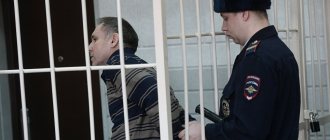ST 117 of the Criminal Code of the Russian Federation.
1. Infliction of physical or mental suffering through systematic beatings or other violent actions, if this does not entail the consequences specified in Articles 111 and 112 of this Code, is punishable by restriction of freedom for a term of up to three years, or forced labor for a term of up to three years, or imprisonment for the same period.
2. The same act committed: a) in relation to two or more persons; b) in relation to a person or his relatives in connection with the performance of official activities by this person or the performance of public duty; c) in relation to a woman who is known to the perpetrator to be pregnant; d) in relation to a person who is known to be a minor or a person who is known to be in a helpless state or in financial or other dependence on the offender, as well as a person who has been kidnapped or taken as a hostage; e) using torture; f) by a group of persons, a group of persons by prior conspiracy or an organized group; g) for hire; h) for reasons of political, ideological, racial, national or religious hatred or enmity, or for reasons of hatred or enmity towards any social group - is punishable by imprisonment for a term of three to seven years.
Note : In this article and other articles of this Code, torture is understood as the infliction of physical or mental suffering for the purpose of forcing a person to testify or take other actions contrary to the will of a person, as well as for the purpose of punishment or other purposes.
Torture - what is it?
The official definition of this concept is given in Part 1 of Article 117 of the Criminal Code of the Russian Federation. Namely: torture is the infliction of physical or mental suffering through systematic beatings or other violent actions , if this does not entail the consequences specified in Articles 111 and 112 of the Criminal Code of the Russian Federation.
In simple terms, torture is expressed in the infliction of any negative physical impact on the victim by the criminal, from which she suffers (stress, physical and emotional pain, humiliation, etc.). However, there are no signs of serious or moderate damage to the victim’s health.
Where to apply
A report of torture should be filed with the police. The application can be submitted in writing in person, orally by telephone or online to the police department at the place where the crime was committed. It should be borne in mind that cases of crimes under Art. 117 of the Criminal Code of the Russian Federation relate to cases of public prosecution that can be initiated by the police if they become aware of the fact of torture not from the victim herself, but from other sources, for example, from eyewitnesses of the crime or from those who were not eyewitnesses, but learned about him from other persons.
Kinds
Torture can be expressed in two main forms , which have several subtypes.
- Systematic beatings . In this case, systematicity should be understood as numerous blows inflicted by the criminal on the victim at least 3 times. That is, if the culprit hit (tortured) the victim again several years later, such treatment of a person will not be punished under Article 117 of the Criminal Code of the Russian Federation.
- Other types of violencethat cause suffering to the body and psyche of the victim. This includes causing pain for a long time by:
- pinching;
- sections;
- causing multiple (significant and minor) harm to the body with the help of sharp and blunt objects;
- exposure to thermal factors;
- prolonged deprivation of food, water or heat;
- placing the victim (leaving him) in conditions harmful to health, etc.
Examples of torture include torture with a hot iron or boiling water, blows with a stick or baton, exposure of the victim to open fire, injections, and small cuts on the skin with a knife.
Corpus delicti
Traditionally, the elements of a criminal act include: the object and the objective side, as well as the subject and the subjective side. Each of the components of Article 117 of the Criminal Code of the Russian Federation is described in more detail below.
Object and objective side
The direct object of the crime under Article 117 is the health of the citizen. In this case, there is no mention of a person’s life, because serious or moderate harm to the victim is excluded . Actions that fall under the signs of torture cannot lead to any significant consequences for the life of the victim in advance.
The objective side is understood as the act of the culprit in the form of an action - causing suffering (both to the body and the human psyche) through systematic beatings and other types of violence listed above.
Subject and subjective side
The subject of the composition in question is a sane 16-year-old individual , and the subjective side is expressed exclusively by direct intent.
By mocking the victim, the criminal (torturer) wants him to experience physical and moral suffering and, therefore, deliberately mocks him, continuously committing negative actions.
Qualifying features
Their list is contained in Part 2 of Article 117 of the Criminal Code of the Russian Federation. The attacker will face a more severe punishment if at least one of the following conditions of torture is present :
- In relation to 2 or more persons.
- When a criminal commits a crime in relation to a citizen who is at that time in the service or performing a public duty (or in relation to his relatives).
- Torture of a pregnant woman when the perpetrator knew about it in advance.
- In relation to a minor (and the culprit knew about his age) or a helpless person (in particular, if there is a financial dependence between the criminal and this person).
- If the victim is kidnapped or taken hostage.
- Using torture.
- When torture is carried out by several persons (with or without prior agreement, or it can be an organized group).
- By hiring another person to carry out the torture.
- If at the time of the crime the victim had motives of hatred (or enmity) based on politics, ideology, race, nationality or religion.
Essence of the question
Every citizen in our country has certain rights and freedoms. They are protected by various laws and must be respected by all members of this society. And those who violate them must bear responsibility for it. In cases where there is violence against a person, the concept of “torture” appears. Article 117 of the Russian Criminal Code is dedicated to him. Before you start reading the law, you need to understand this term. What is torture?
Lawyers understand by it suffering, both physical and mental, that was inflicted on a person as a result of systematic violent actions (torture, beatings, insults and threats). It is these violations of individual rights that Article 117 deals with. She stands in defense of the victim. We are talking about his right to life and health, given to every citizen by the Constitution. Article 117 determines the punishment for those who decide to break this law. The violator has encroached on the most precious thing for any person and must pay for it.
Demarcation from adjacent trains
Related elements of Article 117 of the Criminal Code of the Russian Federation are:
- Causing grievous bodily harm with particular cruelty, mockery or torture (clause “b” of Part 2 of Article 111 of the Criminal Code of the Russian Federation).
- Clause “c” of Part 2 of Article 112 of the Criminal Code of the Russian Federation is a similar act to the previous one, only in this case the victim is harmed to health of moderate severity.
- Article 116 of the Criminal Code of the Russian Federation – beatings.
Reference. The difference between torture and the provisions of Articles 111 and 112 of the Criminal Code of the Russian Federation is that in the first case the consequences are not similar to those that arise for the victim when severe or moderate damage to health is inflicted.
In other words, the victim does not lose his ability to work for a long time, does not lose any organ , does not acquire a serious illness, etc.
In addition, the subject of the above-mentioned compounds causing damage to health can be a person who is already 14 years old . As is known, for more serious crimes the age of responsibility decreases.
As for the difference between torture and beating, it lies in systematic actions : when the victim was beaten for some time, for example, daily or several times a week. When qualifying violent actions as beatings under Article 116 of the Criminal Code of the Russian Federation, this sign of constant violence against the victim is not present .
An attacker who once committed a beating that did not cause a slight degree of harm to the health of a citizen (and damage of other degrees as well. Read more about determining the degree of severity here), will be prosecuted under the article “Beatings”, and not “Torture”.
Criminal legal characteristics
Torture is caused by various factors. They were carefully studied not only by law enforcement officials, but also by scientists and psychologists. Based on the data obtained, the experts came to the following conclusions that the torture was of the following nature:
- Revenge may be the cause of torture. Bullying, for example, an employee at work leads to the person taking out his anger on other people;
- the cause of torture may be a perverted fantasy;
- sexual dissatisfaction;
- mental disorders and deviations, etc.
In any case, such behavior is considered abnormal and requires various types of checks.
Responsibility
Since torture is a serious crime, the punishment for it has several alternative options, including deprivation of a person’s freedom.
Namely, part one of the article under consideration contains the following penalties (they can be assigned for a period of up to 3 years):
- restriction of freedom (for example, a ban on leaving the city, changing place of residence, visiting certain places);
- forced labor (obligation to work for the purpose of re-education);
- imprisonment (placement of a convicted person in a colony).
Part two of the article lists qualifying features - aggravating circumstances (they were already mentioned in the article), for which an even more severe sanction is provided - imprisonment for a term of 3 to 7 years.
Important. When choosing the type of punishment, the judge is guided by all the circumstances of the case, the nature of the relationship between the victim and the convicted person, etc.
Fair punishment
When committing any illegal actions, a person must remember that for each of them he must be punished. As you know, Article 117 of the Criminal Code consists of three parts. Each of them talks about actions that cause harm to a person and the circumstances in which they were committed. As a summary, at the conclusion of each paragraph, the punishment of the guilty person is determined. Thus, according to the first part, the committed acts lead to the punishment of the offender with imprisonment for a period of 3 to 8 years.
Such a sentence can be called harsh. The deadline will be specified in more detail during the trial after all the circumstances of the case have been clarified. For example, one person intentionally caused another injury in the form of a broken arm. Without going into details, at first glance this is ordinary hooliganism. But if we take into account the fact that the victim is a violinist who plays music professionally, and the criminal committed his act intentionally out of envy, then it turns out that there is a fact of torture. Without mitigating circumstances, he could receive the maximum sentence.
Comments on Article 117 of the Criminal Code of the Russian Federation
What does systematic beating mean?
Comments on Article 117 of the Criminal Code of the Russian Federation indicate that this is a chain of interconnected actions that are united by the general manner of behavior of the attacker towards the victim .
In addition, all actions are aimed at causing constant physical or mental suffering in relation to him , achieving feelings of humiliation and resentment. In light of this sign of torture, some isolated beatings and other acts of violence cannot be considered as such.
If, as a result of violence, the victim’s health is nevertheless caused harm (severe or moderate), this will be qualified under other articles, and additional application of Article 117 will not be required.
Causing mental suffering through threats will not be considered torture. If this sign is present, crimes may fall under Article 119 of the Criminal Code of the Russian Federation.
The corpus delicti under Article 117 is considered formal , that is, it will be completed at the moment of the act itself and for the culprit to be held accountable, the occurrence of any consequences dangerous to society does not need to occur.
What is meant by material or other similar dependence between the victim and the criminal?
There is also a comment on this subject: this sign should be understood as the dependence of the victim in such circumstances :
- dependency;
- living with the culprit in the same living space;
- official communication (between superior and subordinate);
- in an educational institution (between teacher and student).










